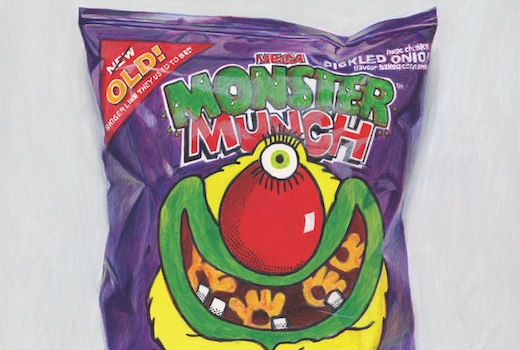WORDS BY NATALIE WHITTLE
ILLUSTRATIONS BY JOí‹L PENKMAN
Issue 1
In Praise of Crisps
A salty kind of love

WORDS BY NATALIE WHITTLE
ILLUSTRATIONS BY JOí‹L PENKMAN
Pungent, artificial, addictive – crisps are a very British obsession, part of a proud heritage shared by children of all ages.
It began in the larder. Nothing behind the door of this cupboard was as pristine as the crisp packets. Every other foodstuff on the shelves had a visible capacity to age, a melancholy fact that was apparent even to small children. We could see that the dried green herbs grew pale and archaeological in their glass jars; the cake flours dimpled with the craters of insects. Biro-labelled jams recorded distant vintage and provenance: "Strawberry, Jane, 1984". But the foil bag of the crisp packet immediately spoke of a bracing future. Crisps were impervious to time.
We lived half-way down an unremarkable lane in the countryside. Behind and around the house was a second larder with fresh things to eat: wild strawberries, trumpet honeysuckle and big white mushrooms greasy with morning dew. We loved all that, but we wanted crisps. I don’t remember any other junk food in our childhood, and the sharing of these packets between three sisters became a high point of passion. I can still hear our vehement squabbling over who was "hogging" the crisps once they had been emptied into a crisp bowl. Such a thing as a crisp bowl became an identifiable part of the kitchen inventory, and the whole spectacle of our crisp consumption often left my father ashen with dismay.
Tuiles, helixes, big griddled ridges – the shapes were testament to the complex industriousness that seemed to be at work in the crisp business
Our first crisp crush was Phileas Fogg, the fictional adventurer whose top-hatted image fronted packets of Mignons Morceaux, a now-discontinued cross between a crisp and a mini-bruschetta. The morceaux were cut thickly into rounds and soaked and baked till stiff with cheese and garlic. The flavourings sat potently on the roof of your mouth and we embraced the adult-strength garlic without question.
With pocket money came choice and satisfying additions to our world: Hula Hoops that could be worn as salty rings on fingers; Monster Munch that imparted a torridly vinegary crunch. It was as if the manufacturers did not expect absolute loyalty: the array of crisps on offer acknowledged whims and fancies. You might not want Frazzles’ dehydrating but wonderful bacon punch every week; nor an everyday mouth-coating of potato produced by Chipsticks’ imitation French fries. And yet, whenever the time came, a precise hit was available.
There doesn’t seem to be another country on earth where children have such a complicated set of choices through a snack-stuff. Tuiles, helixes, big griddled ridges – the shapes were testament to the complex industriousness that seemed to be at work in the crisp business. If the rows of jars in a sweet shop looked bright and appealing, there was always a sobering shopkeeper who patrolled the space between child and tooth rot. The crisp aisle had instant access into childhood’s desires.
Maturity brought the possibility of initiation too: once a teenager inside a pub, you might try the adult-grade Scampi Fries or a flavour-lite cash-and-carry prawn cocktail. Crisps were part of the snacking vernacular of British life – shared by people of all ages.


The fact that all of these varieties were imitations of true tastes was merely part of the fun. You knew prawn cocktail flavour was an approximation whose production had not involved a single prawn, but the game of artificiality was inclusive.
It also turned out to be peculiarly British. Many of our childhood summer holidays were spent on campsites in France, and it was a source of puzzlement that only ready-salted or chive-and-garlic crisps ("chips") were available in their no-nonsense supermarchés. There was compensation in the fact that French crisps came in giant-sized packets, as if to imply that this volume of saturated fat was naturally going to be shared out among a large group of people. But there didn’t seem to be a good reason not to offer more choice. Little did we realise that the French diet was varied enough for them not to bother.
And it is only now that I am an adult that I can look back on my past crisp behaviour and admit to a certain wanton excess. I feel the flesh around my waist and wonder, more often than not, if it’s a beltway of crisps that sits there – a reproach for being too greedy for flavour.
Today I’ve tried and failed to give up the habit. I know I’m ensared. They want adults too, the crisp makers, and they’ve got the flavours to bind us. Through the haze of mature cheddar powder, I cannot see a future without crisps.





